
27TH MAY 1918:- BATTLE BOIS DES BUTTES
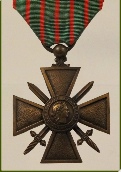
27th May 1918

The following recital is taken from the http://www.keepmilitarymuseum.org The story tells the complete sacrifice the men on the ground gave.

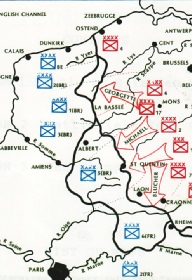
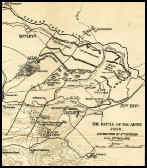
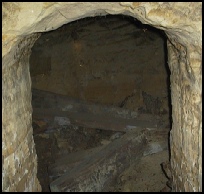
The Withdrawal
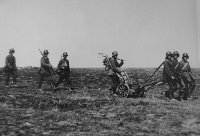
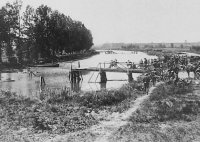
Inspired by the sangfroid of their gallant Commander the whole Battalion...responded with one accord and offered their lives in ungrudging sacrifice.”
Introduction
Over the last seventy three years much has been written about the battle of Bois des Buttes. It was fought by the 2nd Battalion the Devonshire Regiment and 5 Bty RA on the lightly wooded slopes a low sand store hill during the morning of 27 May 1918. The fact that after a gap of some years another account of the Battle has been written testifies to the Battles continuing importance to the Regiment. Not only is Bois de Buttes important regimentally, it also gives examples of the qualities of leadership, of sacrifice and endurance that are as important to soldiers now as they were during the First World War.
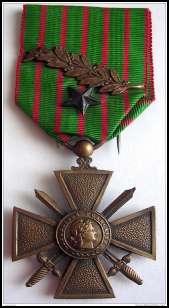
Situation in Early 1918
The collapse of Imperial Russia, releasing in excess of a hundred German Divisions for action in the West and the imminent arrival of American troops in significant numbers, led the German High Command to plan a series of offensives on the Western Front for the spring of 1918. From 21 March 1918 until 5 April the first German offensive codenamed 'Michael', pushed back the British Third and Fifth Armies some forty miles but just failed to break the line. This was followed almost immediately on 9 April by a second offensive, codenamed 'Georgette'; this time against the British First and Second Armies in the North. Once again hard won ground was lost by the British. Of particularly emotive importance was the loss of much of the Ypres Salient, including Passchendaele, the scene of heavy British losses in 1917, but the German advance was held short of the walls of the ancient cloth town of Ypres.
The French Army, though almost 'bled white' by the Germans in the deliberate battle of attrition fought at Verdun the previous year, sent troops to help the British in Flanders. The 'British Divisions most depleted by the spring fighting, the 8th, 21st, 25th and 5th, were so weakened that they could no longer hold an active stretch of the line. The 8th Division, for example, lost 8,513 men March and April and the casualties were replaced by barely trained men. As troops were in such short supply in spring 1918 the Divisions could not be sent out of the line. In consequence they had to be moved to a quiet sector to reorganise, train and take in the recruits from Depots and men transferred from the Army Service Corps. The Divisions were grouped into IX Corps and attached to General Duchenes French Sixth Army further to the South on the River Aisne. IX Corps, under command of Lt Gen Sir Hamilton Gordon, were allocated a sector line of fifteen miles long, between Craonne and Loivre. The 8th Division, of which 2nd Devons were a part, held a front of six miles in the area of Berry-au-Sac and Juvincourt.
The Coming Storm
The Aisne Area
The countryside that the Division found itself in when it took over from the French 71st Division on 12 May was new to British Troops. The country was more undulating than the drab battle-wrecked, Flanders Plain to the North. The weather was fine and 'The front on arrival', says one witness, 'was certainly the most peaceful that the Division had ever been on. It was seldom that a shell was heard'. The line itself, in contrast to the trenches they had just left, was dry, comfortable, with trees and 'even rosebushes'. The historian of the 8th wrote that to the Division, worn out by the spring fighting 'the Aisne front was a welcome and wonderful change'.
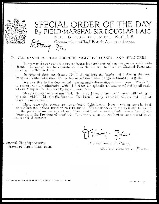
General Haig’s Orders…
The sector occupied by the 8th Division was at the centre of the Corps front and formed a small right angled salient pushed out into the German position. 23rd Infantry Brigade, to which 2nd Devons belonged, occupied the left forward part of the line. All three brigades were in the line due to the length of the front and unfortunately the River Aisne and the Aisne Canal were to the rear of the position in a shallow swampy valley. The sector of Out Post Line taken over by the Devons was not in a good state of repair. Trenches were too deep to fight from, or to shallow or simply half dug. The trenches 'started nowhere and ended in the air'. Company commanders on first visiting the position found the French to be indignant when they were asked to show the Battle positions to the 'R' (Reconnaissance) Groups. The 2nd Devons were in the Out Post Line until 20th May. All was quiet to start with but veterans detected the signs of a coming German attack. Shelling increased perceptibly and on the 18th May the Germans mounted a raid which was driven off, after which the Battalion launched a successful counter raid.
On 20th May the Devons went into reserve south of the Aisne at Roucy and started a demanding training programme for what was virtually a new Battalion. Capt Cope was detached to form the IX Corps Machine Gun School along with a party of trainee machine - gunners. Meanwhile signs of the coming storm were exercising the British Generals. They felt that the current Allied dispositions did not reflect recent German tactical developments and that a lightly held Out Post Line should be north of the Aisne, with the Main Defence line south of the river. This would mean that British artillery and machine-guns from positions on the south bank, could barrage in depth the forward zone, over which the Germans would have to advance to attack the defended river line. This system of defence would also give ample time to destroy the few bridges needed to sustain the light force north of the river. The local French Commanders ignored General Foch's instruction that IX Corps' experience gained in the battles on the Sore and Lys should be used and overruled the British Generals. The results of the decision, as we shall see, were exactly as predicted by the British.
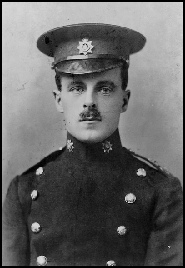
Two Germans, of a unit previously unknown in the area, taken as Prisoners of War on the 26th May, confirmed after interrogation that a German attack on IX Corps area by thirty five divisions was to take place early the following morning. So good had German security and deception been during their concentration that those who had hitherto been steadfastly refusing to believe the signs of an attack only now conceded that it would be a small attack when it came. Preparations were, however, started and during the late afternoon Brigadier Grogan walked into the Battalion Headquarters at Roucy and ordered the 2nd Devons to move north of the river and canal line. They were to occupy some dugouts built by the French and Germans on the sand stone hill of Bois de Buttes. Their mission was to be Brigade reserve 1200 metres behind the Out Post Zone and just behind the Rear Line of the Battle Zone. The Devons had to march forward four and a half miles to Bois de Buttes. The march was illuminated by the flashes from the British and French guns that had started a counter preparation and harassing fire programme at 2100 hours, just as the Battalion left Roucy. The Devons arrived and reported to Brigade Headquarters that they were complete on Bois des Buttes just before midnight on 26/27 May 1918.
The position at Bois des Buttes was on a twin crested hillock about thirty meters high and 500 metres across and was lightly wooded. The hill had featured during the heavy fighting in the area in 1916 and early 1917 and was a mass of trenches that the Devons had little opportunity to become familiar with. Only the "R" Group and company guides had seen the position in the failing daylight. There were a number of large and deep tunnels built through the hill, which were dry and lined with thick timber. The entire Battalion could shelter underground in company sized dugouts, where there was electric light, provisions for the Company and Regimental Aid Posts, as well as ammunition stores. However, they had little more than an hour to set up before, on the stroke of 0100 hours, the previously silent German batteries fired in a single devastating blow. One witness describes 'the night being red with sheets of flame'.
Lieutenant Colonel Anderson-Moreshead
2nd Devonshire
5 Battery RA
The German authorities had realised that their only remaining chance of victory was to defeat the Allies before the overwhelming human and materiel resources of the United States could be deployed. They also had the advantage of nearly 50 divisions released by the recent Russian surrender. The German Spring Offensive, or Kaiserschlact (Kaiser’s Battle) began on 21st March 1918, but more properly was not one, but four separate sequential offensives.
8 Division with 5 Battery had been engaged in heavy fighting on the Somme in March and April 1918. The Germans had made many territorial gains during offensives MICHAEL and GEORGETTE , and their storm troopers had been particularly successful at seizing and exploiting weaknesses in the Allied lines. Following desperate fighting the British Forces had taken severe casualties and were in no condition to hold an active sector of the line. It was decided they would be moved to a quieter French area in the vicinity of Reims, in exchange for fresh French troops.
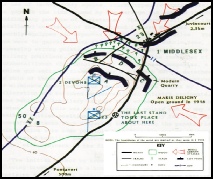
On 12th May, 5 Battery moved to a position at Bois des Buttes, one mile south of Ville aux Bois under their BC, Major J C Griffiths MC. The Battery was equipped with six 18-pounders and had two OP parties commanded by Lieut C Counsell, and 2nd Lieut. HReakes.
Unluckily for them, the move of the British troops coincided with the next phase of the German offensive, code-named BLUCHER-YORCK. This was to be a new attack on the French line, designed to draw forces further away from the Channel and allow renewed German progress in the north. The strategic objective remained to split the British and the French and gain victory before American forces could make their presence felt on the battlefield. Ironically, the British troops had moved from the frying pan into the fire.
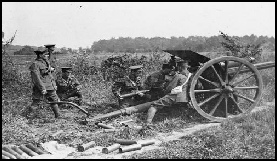
18 Pounders in action
Throughout the offensive of 1918, the Germans used the novel artillery tactics of Lieutenant Colonel Georg Bruchmüller. Known as the Feuerwalze, (or Waltz of Fire), this was an effective and economical artillery bombardment scheme. There were three phases: a brief attack on the enemy's command and communications, destruction of their artillery and lastly an attack upon the enemy front-line infantry defences. Bombardment would always be brief so as to retain surprise. Bruchmüller's tactics were made possible by the vast numbers of heavy guns (with correspondingly plentiful amounts of ammunition for them) which Germany possessed by 1918. It was possible for the Germans to launch an offensive at almost any vital part of the front without giving the Allies notice of their intentions by moving guns and shells to the threatened sector.
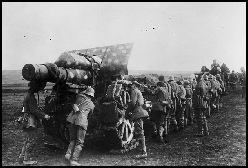
BLUCHER-YORCK was to attack across the line SOISSONS-REIMS but did not have sufficient heavy artillery to attack the whole front so a concentrated attack was planned for 37 miles of the Allied line between Beuilly and Brimont. Troops, guns, ammunition and supplies were moved at night to avoid detection, and on the eve of the attack there was one battery for every 100 meters of frontage being attacked and at least one battery to fire on each British or French battery within range.
The sector was partly held by six British divisions which were "resting" after their exertions earlier in the year. In this sector, the defences had not been developed in depth, mainly due to the obstinacy of the commander of the French Sixth Army, General Duchêne.
The German tactics so successfully used in both Michael and Georgette were now being used again in "Operation Blucher". The British fears were realised. The Out Post Line and main defensive lines were both subjected to a bombardment by massed German Trench Mortars at a range of 50 - 300 meters and the 2nd West Yorks in the Out Post Line suffered terribly. Trenches were blown in, dugouts collapsed and defensive wire was cut. Further back, the Devons and the British artillery positions, nearly all north of the Aisne, were subjected to a ten minute bombardment of gas shells. The positions were all well known to the enemy and an extremely effective concentration of gas was delivered by the German guns as far back as Divisional Headquarters, in Roucy, and the Unit Transport lines. Colonel Bruchmuller, the German Army artillery planning genius, to whom much of the credit for the German successes of early 1918 must go, had over six thousand guns under his command.
He was insistent that mathematical survey was used to register targets rather than observed fire. Thus he reserved the element of surprise or at least doubt in the enemy's mind. The fire of field and medium gun batteries was concentrated on British positions in turn, though every known position was allocated a battery for the entire period of the bombardment. The time the maelstrom of flame and steel reached its peak, when all available German guns were laid on to Bois des Buttes, is not recorded by the Devons but 'its intensity passed all hitherto experienced'. Just to the rear of the Devons, 5 Field Battery RA was the fourth battery to receive the attentions of the massed German artillery at 0335 hours. The worst of their ordeal lasted five minutes. The guns and their crews in shallow dugouts on the Gun Position suffered heavy casualties and the survivors were left shocked, dazed and deafened with four serviceable guns.
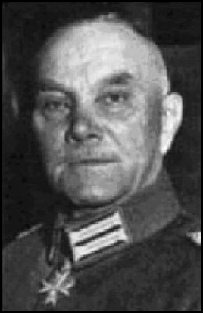
The Battery were at this time under the command of Capt John Hamon Massey as on the 19th May the wagon lines consisting of the horses and gun limbers had moved back to Burgoyne to be joined on the 25th May by the BC who had gone back to join them for a few days rest. Lieut C Counsell and his OP party were forward with 2nd Battalion West Yorkshires and 2nd Lieut H Reakes was at the OP bunker at Wagram. Having been in position for several days the Battery had prepared adequate field defences. The guns were in two sections of three with gun and ammunition pits for each gun and local defence trenches for the position. From 21:00hrs on the 26th May the guns fired harassing fire missions on likely enemy approach routes and the position was prepared for the imminent attack with sufficient ammunition to fire throughout the night.
In comparison the Devons still familiarising themselves with the position, had deep dugouts to shelter in. Just before 00:45 hours the Commanding Officer, Lt Col Anderson-Morshead, was holding an 'O' (Orders) Group in the Headquarters dugout. Positions had been allocated for companies to occupy when ordered to deploy from the shelters. Runners and a fatigue party had been detailed to collect additional ammunition from a dump just south of the river. The CO was sharing a single glass of whiskey with his company commanders before sending them back to their dugouts. The assembled group were commenting on how quiet it was and, suggesting hopefully, that it was all another 'wind-up', when at 01:00hrs there was a dull thud as two gas shells exploded. They were followed by a “mighty roar” as the German barrage began. The vast majority of the Battalion were underground so casualties were very light; however, it was impossible for anyone to move out of the dugouts. Consequently ammunition fatigue parties never left the position.
The Germans then broke into the rear of the gun position. Capt Massey had not returned so Lt Large took command, despite his wounds, and continued the direct fire on the enemy attack. 2Lt Button went to the Command Post and set about burning the maps and documents. The members of the battery were now engaging the enemy with their personal weapons as well as with the guns. With the position almost lost, Lt Large gave the order to remove and destroy their breech-blocks and dial sights; as he did this he was shot through the lungs and died. 2Lt Button threw himself into the fight and was also killed moments later.

The remainder of the Battery fought on hand to hand with the enemy, but of the three officers and 46 NCOs and men of 5 Battery RFA on the gun position, only six men escaped death or capture - Gunner Sowerbutts and Sergeant Schofield MM fought their way out with rifles and four unarmed men, Gunners Cocking, Frazer, Haigh and Mant, escaped. Sgt Schofield MM died of his wounds on 6th June 1918 and is buried at St Sever Cemetery, Rouen, France. Capt J H Massey’s body was discovered in 1935 and he is buried at Jonchery-sur-Vesle British Cemetery, France. For his conduct on the 27th May he was awarded an MC and the Croix de Guerre. Lieut C E Large and 2nd Lieut C A Button were awarded the Croix de Guerre, Gunner Sowerbutts was awarded the Military Medal for his effort to get Sgt Schofield to safety and Gunners Cocking, Frazer, Haigh, and Mant were awarded parchment certificates.
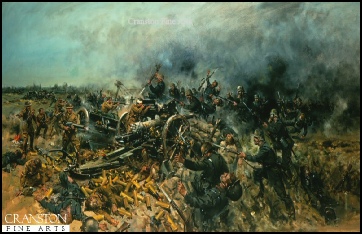
The German Artillery High Explosive and Gas barrage that would last on and off for the next five and a half hours but during this time 5 Battery continued its fire. On realising the men could not keep up this heavy work for prolonged periods, Capt Massey organised a system of relief's with an NCO and two gunners manning each gun at any one time with the remainder in cover. Lieut Large and 2nd Lieut Button helped out with the manning of the guns while Capt Massey moved from gun to gun encouraging the men and reminding them of their duty to the Royal Regiment. During one of the barrages Lieut Large was injured by an enemy shell while helping on one of the guns. Although he had lost most of his right foot he refused to leave the Battery.
By 05:00hrs the 2nd Devonshires were engaged with a large enemy force and had no artillery support due to most of the guns being knocked out by the German counter battery fire or having no means of communications. At 06:30hrs the German artillery fire on the 5 Battery position stopped just as German infantry were spotted 200 meters from the position. Capt Massey ordered the guns to direct fire in defence of the position, and under this effective fire he took a Lewis Gun and four gunners armed with rifles and set out towards Wagram to drive the German infantry back.
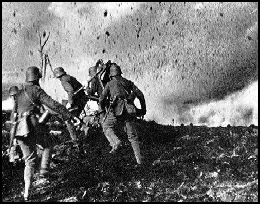
The first blow was mighty but brief and was followed by a concentration of gas that quickly crept into the dugouts. The uncomfortable but effective gas masks were donned and wet blankets were hung over the doorways to keep the levels of gas in the dugouts to a minimum. There was no panic as the longer serving Devons were familiar with gas and the newer members were well drilled and followed the example of their seniors. The night was already hot and soon conditions became almost unbearable for the men packed tightly in the airless dugouts but deep underground they were safe from 'the hell outside'. Time dragged without news of what was going on anywhere on the front as even the deeply buried telephone line had been cut and runners failed to return.
2nd Devonshire
At first light, approximately 04:00 hours, Lt Col Anderson-Morshead ordered the Battalion to deploy to battle positions. The companies appeared from their shelters into the growing daylight and found that the Aisne Valley was shrouded in mist. Little could be seen on the open ground to the front. However, the high ground, to the rear at Roucy and to the front, at the Chemin des Dames stood out above the mist. As the Battalion made its way forward, through the mist and leaves shell fire it found that many of the trenches had been reduced to shallow hollows during the course of the 3 hour bombardment. Up to this point only a handful of casualties had been suffered from the initial fire and were mainly runners braving the barrage. From this point onwards the Battalion was to suffer a steady flow of casualties from the continual heavy shell fire.
B Company on the left occupied a line of partly blown in trenches looking North West towards Corbeny. Overlooking the ruins of La Ville-aux-Bois was D Company occupying similarly damaged trenches in the centre forward position. To their right was C Company covering the flat marshy ground to the north east. Once the Commanding Officer had sent out the Companies, all communication with them was lost. The telephone line was destroyed by shell fire and runners quickly became casualties as they ran in the open from shell hole to shell hole. From the trench above his Command Post Lt Col Anderson-Morshead could not see the forward Company positions due to the foliage, the shape of the ground and the mist. Smoke and dust from the barrage made matters worse. So from the outset the forward Company commanders, all lieutenants, were on their own to execute the 6th Army order that 'not an inch of sacred French soil was to be surrendered'. A Company was, however, with the Commanding Officer in the trenches surrounding the hill top.
Almost immediately after the Devons deployed to their battle positions, B Company came under attack from the left by elements of the German 50th Division. The Germans had moved quickly through the British 50th Division's position and approached Bois des Buttes undercover of the mist. The Battalion was initially attacked by heavily armed sturmtruppen infantry. The first wave that appeared out of the mist, soldiers of the 158th German Infantry Regiment, took cover from the rapid fire of the riflemen and B Company's two Lewis guns. Out of the mist, over the heads of the first wave, came dozens of rifle grenades that caused heavy casualties to the men of B Company sheltering in the trenches. After a while the German riflemen who had taken cover about fifty metres away in dead ground and shell holes 'Jumped up and rushed us' while a second wave continued to give covering fire. 'The boys kept blasting away and this attack was beaten off'. Fire from the rifle grenades resumed causing even greater casualties to the Devons. A third wave of Germans charged through the mist 'hurling stick bombs into our trench' and they too were beaten off with heavy casualties. Following this, the artillery barrage resumed, further thinning the depleted ranks of the Devons. The Battalions deployment under fire and B Company's success in beating off a surprise attack from a powerful force were the first examples of the determined defence against great odds that was to characterise the Battle.
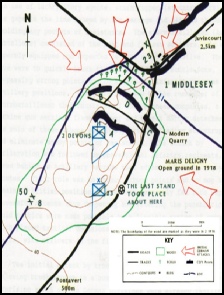
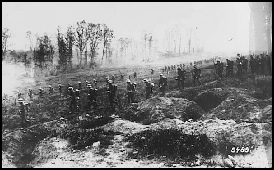
The fight for the hill
Subsequent attacks on all three forward companies followed the same pattern except that as the mist burnt off with the rising sun great execution was carried out by the Lewis gun teams who were 'sweeping down great numbers of Germans'. The longer ranges after the mist had disappeared meant that the Devons, in the centre of the breakthrough, were able to disrupt the move forward of enemy artillery and stores essential for their continued success. The positions in Bois des Buttes, now recognised by the Germans as a point of stubborn resistance, drew the attention of the German Imperial Air Force. Planes, of a number of types, machine gunned and bombed the Devons at the edge of the wood and dropped smoke markers for the German field guns to aim at. The aircraft also dropped message containers with fire orders for their medium guns. Cpl Wotton, a survivor from C Company, recalled his section quickly learnt to change position after the over-flight of a German aircraft as it would invariably be the harbinger of another salvo of accurate shell fire. Another aspect of the air war in this battle was the German use of observation balloons tethered to tanks. These followed the advancing infantry at a safe distance. A couple of balloons to the east brought down accurate artillery fire on the Devon's position.
The Commanding Officer concerned at the failure of runners to return dispatched his trusted batman LCpl Jordon, to get information. However, hearing the attack on the left he also sent Lt Maunder and Headquarter Company were forward to reinforce B Company but they met groups of men coming back saying that there was no longer front line, the enemy were close behind them and that they had orders to retire. Lt Maunder had these men join his party of Regimental cooks and signallers to establish a line of sorts on the side of the hill. They took up positions in old trenches and shell holes and held the Germans who arrived shortly afterwards.
Out-flanked on the left and severely reduced in numbers, D and C Companies were forced back into the wood. Young inexperienced troops, many in their first battle, having endured so much shelling, losing so many of their Officers, NCOs, and fellow soldiers, could have been forgiven for heading for the safety of the river line as quickly as possible. But the Devons made the Germans fight for every inch of the wood. The following extract from a letter by Pte Borne, who died of wounds aged 20, exemplifies the spirit of the Battalion. He wrote:
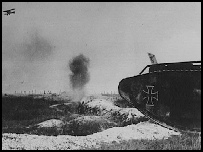
I was with the Lewis gun team, and we were first in action. All my pals were speedy casualties Lads were falling right and left but I had a capital weapon in the Lewis gun, which I was firing steadily at the German hordes. I looked about, and I seemed to be all alone. Still, I kept on firing at them. Then, when the enemy waves were about 100 yards away, things got a bit too warm, so I picked up the gun, ran back about 100 yards, and had another go.
2Lt Clarke of 6 Platoon had earlier successfully led the remains of his platoon to safety on the Southern banks of the canal and river. Having fought off attacks in strength, B Company was forced to retire. They quickly discovered that they were almost surrounded. The platoon struck off through the maze of trenches, encountered the enemy and "got rid of them and tried in the opposite direction, with the same result. Eventually, they found a clear route up to the crest of the hill where they made their way through the tunnels to emerge on the Southern side in a hail of bullets from every direction including from enemy aircraft above. 2Lt Clarke led the survivors through the wood towards Pontavert where through, as described in the Regimental History, his skill and coolness, he managed to cross the bridge and join Brig Grogan and a mixed group of soldiers on La Platerie where they held the Germans for a significant period of time.
Altogether a total of 552 members of 2nd Battalion, the Devonshire Regiment died or were taken prisoner during six hours of battle on the morning of 27 May 1918. The battle of Bois des Buttes is the Regiments bloodiest action even eclipsing that of Salamanca that earned the Devons the nickname 'The Bloody Eleventh'. Approximately forty men escaped to safety across the river and they, along with men from the Battalion Transport Lines and Devons from Capt Copes Lewis Gun School, continued to play a vital part in containing and slowing down the German breakout. The tale of the next five days is a story that is a worthy sequel to Bois des Buttes. Suffice it to say that the front was eventually stabilised on the River Marne and the Germans held forty miles from Paris.
The Reckoning
Historians when assessing the merits of a First World War unit actions use two main criteria when making their judgement. Firstly, they examine the facts to see if the unit had a choice of standing and fighting or withdrawing whilst they still could. The second criterion is one of whether the unit's action had a wider grand tactical or strategic impact on the outcome of the battle as a whole. The engagement fought by the 2nd Devons at Bois des Buttes, using the above criteria, is widely thought to rate amongst the top three unit actions of Great War. Faced with a bombardment of unprecedented ferocity, a flow of defeated men from the forward battalions, being outnumbered by the Germans and having a major obstacle in the form of the river and canal to the rear of the Battalion makes the Devons stand quite remarkable. Units in similar situations normally withdraw by the consent of the will of the majority. The tunnels were of course a significant factor in the battle but the key to the Devons stand at Bois des Buttes was without a doubt the leadership of Lt Col Anderson-Morshead whose spirit, determination and sense of duty had influenced the Battalion from top to bottom. In the words of General Berthelot's Ordres du Jour:
The 2nd Devons not only earned laurels for their glorious selfless stand but also influenced the course of this, the Battle of the Aisne, by delaying the German advance for crucial hours.
The Devons assisted the 21st Division, who had held the enemy in their Battle Area, to withdraw in good order. In addition they also bought time for Brigadier Grogan amongst others to organise ad hoc lines of defence that further delayed the enemy until the line was finally stabilised four days later. In Clauswitizian terms the Devons were a handful of sand thrown into the well oiled German Military Machine, causing friction that lowered the general level of performance and so caused the Germans to fall short of their intended goal. This was achieved by the Devons tying down large numbers of German combat troops urgently needed for other tasks. The Devons also in their position astride the Juvincourt, Ville aux Bois, Pontavert road delayed the move forward of subsequent echelons of infantry and more importantly guns and material necessary for the maintenance of the momentum of the offensives. It was not only for the Battalions heroism that the French awarded the Battalion the Croix de Guerre, but also for the concrete results that they achieved in delaying the Germans for a significant period. The 2nd Devons were the first British unit to be so singularly honoured with the Croix de Guerre.
The RSM was forced to empty the ammunition pouches of the dead as the surviving riflemen were running out of ammunition. It was on one of these expeditions that his seemingly 'charmed-life' ran out when he was taken prisoner by six Germans who rushed him from behind. The stand of the Devons was now over. The few remaining soldiers of Battalion Headquarters and A Company, with Capt Burke who was wounded in the foot and unable to stand, now started to make their way back towards the river line avoiding the Germans who were moving towards the crossings in great numbers. Some horribly wounded, such as Lt Clegg, dragged themselves almost a mile to the outskirts of the river only to be taken prisoner by the Germans. Many of the fit men such as Lt Hill of B Company and survivors of his 5 Platoon fought all the way back to the riverbank and when out of ammunition, he and three soldiers were taken prisoner. Others swam the river and canal only to be captured by the waiting Germans on the "friendly bank".
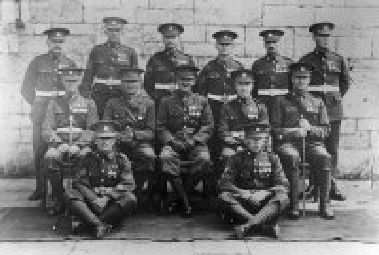
| Registration |
| The Team |
| Branch Members |
| Tour Gallery |